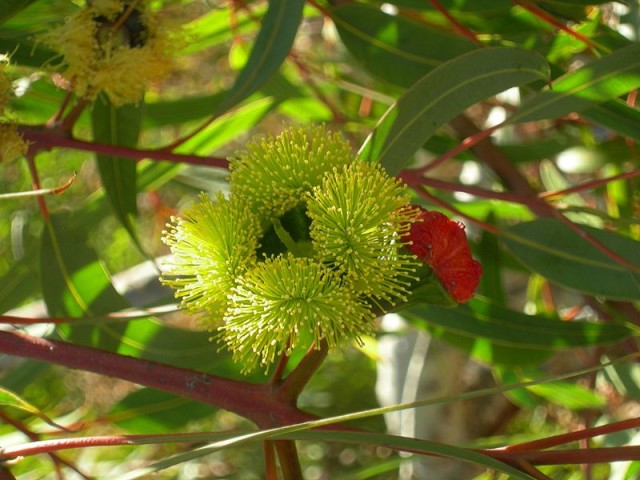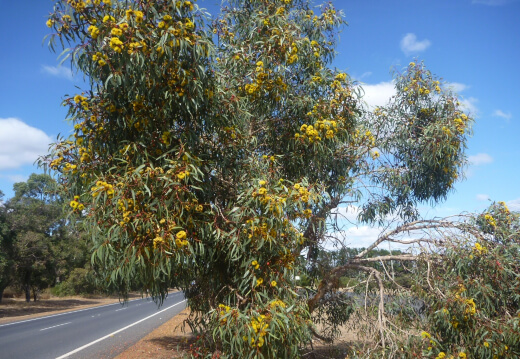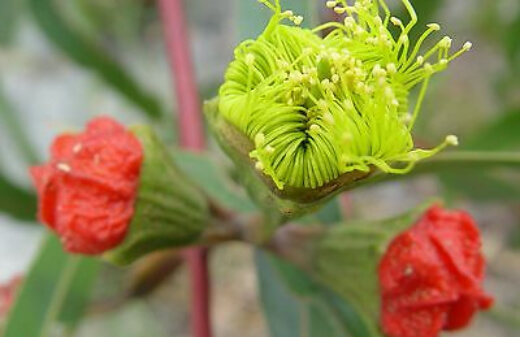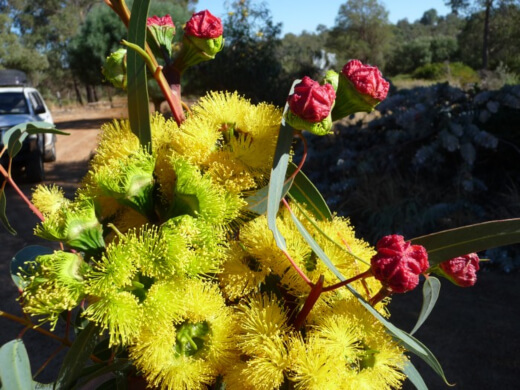Looking for some spectacular flora to add to your garden? Eucalyptus erythrocorys is an exciting evergreen and fast-growing species of Eucalyptus or gum tree. With bright beautiful blooms and fairly straight forward care instructions, it’s easy to see why many people opt for this Aussie native.
Follow our growing guide to help you propagate, plant, grow and care for Eucalyptus erythrocorys in your own garden.
More...
What is Eucalyptus erythrocorys?
Family: Myrtaceae
Genus: Eucalyptus
Species: E. erythrocorys
Common Name: Illyarrie and red-capped gum
Flower Colour: Yellow
Foliage Colour: Green
Growth Habit: Small Tree
Flowering: Summer to Autumn

Eucalyptus erythrocorys form part of the Myrtaceae family and is native to western parts of Australia. This tremendous tree has striking dark green, sickle shaped leaves with beautiful flowers covered in tufts of gold stamens.
Growing as much as 4 to 8 metres over its lifetime, this species is ideal for gardens and will attract an array of birds and butterflies.
It’s also drought and frost tolerant. When cared for correctly, it can even be grown indoors. Other common names for this species include the red-capped gum, illyarrie or the helmet nut gum.
How to Grow Eucalyptus erythrocorys
Red cap gum trees do particularly in warmer, Mediterranean climates but due to its frost tolerance and adaptability, can be grown in most environments.
Red-capped gum trees enjoy afternoon sun, so when choosing a spot to plant consider somewhere with partial shade. Most importantly, you’ll want to ensure well-draining, loam soil.
Limestone soil is also a great choice for Eucalyptus erythrocorys. Try to maintain a slightly more alkaline soil pH level.
Growing Eucalyptus erythrocorys from Seed
Many Eucalyptus species are easily propagated from seed and Eucalyptus erythrocorys is one of the easiest to propagate.
Whilst you can harvest seeds directly from the Eucalyptus illyarrie tree, it is recommended to source your seeds from a provider to ensure that the seeds are not dormant.
The ideal time to sow your seeds is in spring and early summer when it is still warm.
Here’s how you can sow your seeds:
- Step 1 - Fill your seedling tray with a porous seeding mix and shallow sow seeds about 2 to 3 mm deep. You will want very little soil on top of the actual seed.
- Step 2 - Place your seedling tray in a semi-sunny spot to sprout.
- Step 3 - Keep the soil moist whilst sprouting. It is recommended to use a fine mister to avoid water logging the soil.
How long does it take to grow eucalyptus from seed?
Germination will generally take anywhere between 14 to 21 days. Once you begin to notice at least two true leaves you’ll be ready to transplant into a container or into soil.


Get Your Free Guide:
Master Growing Australian Natives eBook
A Must Have Complete Guide for Every Australian Garden
Get Your Free Guide:
Master Growing Australian Natives eBook
A Must Have Complete Guide for Every Australian Garden
Can you propagate eucalyptus from a cutting?
While it may take slightly longer, you can propagate eucalyptus trees from cuttings. Use a clean, sharp set of pruning shears to make a cutting of about 7 to 12 centimeters long.
The cutting should have at least one budding leaf. Should the cutting have sprouted leaves, be sure to remove them. You can either dip the cutting into rooting hormone or embed into a potting medium.
Eucalyptus erythrocorys Growth Rate
Eucalyptus erythrocorys is known to have a particularly rapid growth rate. In the right conditions, the red-capped gum can grow as much 91 cm per year.
When transplanting, be sure to place young plants at least 30 to 60cm apart to ensure plenty of space to grow.
How to Care for Red-Capped Gum Trees

Source: gardeningwithangus.com.au
You’ll find fairly straight forward care instructions when it comes to Eucalyptus erythrocorys or the red capped gum. Young plants will grow really quickly and flower annually between the summer and autumn months.
Watering
Young plants will require rigorous and regular watering, especially during the growing season. In general, a deep soaking every couple of days will suffice. Cut back on watering during particularly wet or cold seasons.
Regular Fertilisation
Regular fertilisation is important for general plant care. Younger plants should receive a high-phosphorus fertiliser to encourage root development.
Thereafter, switch to a native slow release fertiliser and feed every few months.
Regular Pruning
Regular pruning will be important for your red-capped gum tree’s health. Pruning can be slip into three types: pinching and thinning, shearing and rejuvenating.
Pinching & Thinning
- Annual removal of stem tips will help stimulate the growth of stronger stems.
- Removing droopy branches will also help promote stronger branches.
- Stem tips should be cut back towards the end of the winter season.
Shearing
- Shearing with shears or hand-saw can be done to level and control tree size.
- Cutting back can be done during the winter months.
Rejuvenating
- The removal of old, dead branches will help to keep your red-capped gum rejuvenated.
- This can be done at any point in the year.

When it comes to pests and diseases, this species is barely susceptible and quite hardy. Should you notice big holes on your leaves, you may have an issue with a Eucalyptus beetle.
Although uncommon, it can quickly become problematic so be sure to treat your with insecticide immediately.
Red Capped Gum Uses
The red-capped gum has long been known to be used as an ornamental, accent tree. Plus, this species has a stunning scent quite similar to menthol which is why it’s often used in gardens.
Add it as an accent in your flower beds or use it as a decorative garden tree. You won’t regret adding this species to your collection. Red capped gum trees also make wonderful container plants.
Plus, if it’s during the blooming season, eucalyptus illyarrie makes fantastic, scented foliage for flower arrangements. More so, eucalyptus has long been known to have herbal and medicinal benefits.
Eucalyptus erythrocorys Frequently Asked Questions
How do you prune Eucalyptus erythrocorys?
Young Eucalyptus erythrocorys trees have weak branches that can snap under the weight of dense flowers and berries. Pruning your eucalyptus to remove developing fruit will help to protect against this.
Mature trees can be cut back to the ground each year to control the plant, or with leading stems cut back in alternate years to maintain winter interest.
Do Eucalyptus erythrocorys grow back every year?
E. erythrocorys is a half-hardy tree that will flower each year, and will grow back every year if cut to the ground. If left without pruning, your eucalyptus tree will continue to grow healthy to around 10 m tall.
Which Eucalyptus has yellow flowers?
Plenty of eucalyptus trees have yellow flowers, but few are as striking as the wash of yellow blooms displayed by Eucalyptus erythrocorys through summer and autumn.
Its yellow flowers emerge from tight buds, like summer fireworks, displaying vivid custard-coloured petals and reproductive parts.
Can I cut the top of my Eucalyptus erythrocorys?
E. erythrocorys respond well to hard pruning, so you can simply cut the top off your plant each year to limit its size, or utilise the stems and leaves for tinctures or hanging around the house as an insect repellent.
What are other names for Eucalyptus erythrocorys?
E. erythrocorys is usually known by its common name, Illyarrie, but can also be called red-capped gum or the helmet nut gum tree.
What is the best place to plant Eucalyptus erythrocorys?
The best to plant E. erythrocorys is in full sun, on reasonably well-drained soil. Unlike some eucalyptus, Illyarrie can cope with moist soil for a few weeks over winter, so it’s not essential to improve most garden soils before planting, but it does help to prevent boggy conditions where possible.
Is Eucalyptus erythrocorys frost hardy?
E. erythrocorys are reasonably frost hardy. These trees are well adapted to changing temperatures and can cope with anything down to about -5°c, so for most of Australia, you won’t even need to worry about young saplings.
However, if you are expecting heavy rainfall or prolonged frosts, then protect seedlings or young trees in the ground.
When does Eucalyptus erythrocorys flower?
E. erythrocorys flowers from summer through to late autumn. In some parts of the country, that can be earlier, and flowering can go on for longer, even into early winter.
In most cases though, Illyarrie is a summer flowering eucalyptus.
How tall is Eucalyptus erythrocorys?
E. erythrocorys grows to an ultimate height of 10m in nature, and looks stunning when fully grown, with thick peeling trunks. For me, the biggest appeal is the bark though, so pruning back low for a few years will help to create a lower-growing, multi-stemmed tree.
Is Eucalyptus erythrocorys invasive?
E. erythrocorys aren't invasive. It is native to Australia and slow to spread in cultivation. The roots of E. erythrocorys are tough, but will not damage property or structures, so can be planted pretty much anywhere in the garden.
Is Eucalyptus erythrocorys good for wildlife?
All Eucalyptus trees are brilliant plants to add to wildlife gardens. They encourage native birds and insects and provide pollen and nectar all year round depending on the species.
E. erythrocorys also add fruit to the list, making them highly useful in wildlife gardens.
What are the benefits of Eucalyptus erythrocorys?
E. erythrocorys, like all eucalyptus trees, can be used as a pest deterrent, either by mixing your own tinctures or simply drying and hanging leaves around your wardrobes to deter moths and other pests.
In the garden, its mere presence is often enough to keep midges away from your patio.

Wrapping Up Our Eucalyptus erythrocorys Guide
Quintessential and striking, you’ll love having some of this beautiful species in your backyard. Bright and beautiful, you’ll love having the vibrancy of this plant in the blooming season.
Plus, you’ll get to enjoy the remarkable birds, bees and butterflies illyarrie will bring to your backyard.
Be sure to pick the right semi-shaded spot in well-draining soil when planting and keep up with regular pruning to guarantee a happy and healthy plant.
Follow our growing guide and you’ll enjoy having blooming, beautiful Eucalyptus erythrocorys or illyarrie in your garden.
Published on January 19, 2023 by Nathan Schwartz
Last Updated on January 24, 2025






Could you please advise me of where I could buy some Eucalyptus Erythrocorys ( Illyarrie) plants from . And if I can buy them can I get them in tubes. Regards Peter Williams
Hey Peter,
What state are you in?
I can supply seed pods straight from the tree,is this useful
i purchased a seedling that is meant to be an Illyarrie – Eucalyptus erythrocorys.
the juvenile foliage is tomentose white
is this a feature of the species
There are plenty of Eucalyptus erythrocorys seedlings in tubes in Bunnings (Melville store).Hope it helps
I have just planted 2 Red Cap Gum’s, how long do they take to grow?
Kind Regards
Sue
Great street verge trees, especially when mixed with Albany red flowering gum, Corymbia Ficofolia
Hi you are saying eucalypus erythrocorys to have high-phosphorus fertilize when first planted.
I am confused as other eucalypus are not to have any phosphorus fertilize.
Please help me out thanks irving
Hi,
Thank you for your comment! If the tree is very young, phosphorus is needed to help the roots grow deep and strong. You are right that native plants don’t generally respond well to phosphorus, but in the early years before it becomes established, it is a good idea to use a fertiliser that has some phosphorus in it, like a 3-2-13, 17-5-17, 18-3-18, or 20-3-19.
You can lightly apply this as per the manufacturer’s instructions at least once during the main growing season. After a few years, when the tree is established, it should only need a very light dose of a native plant fertiliser once a year.
Kind regards,
The Sumo Team
Eucalyptus erythrocorys is a species (erythrocorys is lower case) not a Cultivar. Other than that an excellent article
Hi Doug,
Happy New Year! We appreciate you taking the time to reach out. We are currently updating our articles to follow the correct letter case for species and cultivars and have now updated this article and soon the whole site will be updated correctly. Thanks again, and hope you have an amazing 2025.
Cheers,
Gary Clarke